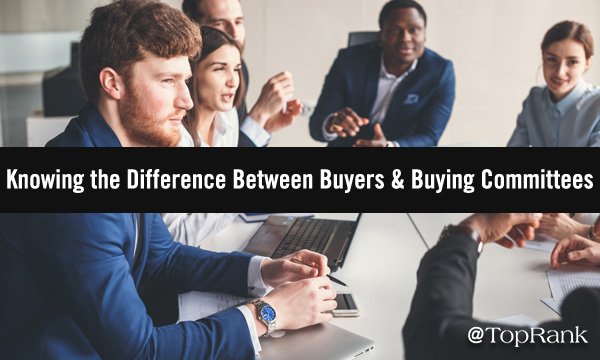
Working as a marketing or sales professional in B2B presents a unique set of challenges and hurdles. One that probably doesn’t get discussed enough is the nuance of trying to reach and engage buying committees, as opposed to single customers. It’s a hugely important distinction that too many strategies fail to fully account for.
If you’re not speaking to everyone, you might be speaking to no one. And we all know where that leads.
The Expanding Buyer Committee
A buyer (singular) is a sole decision maker responsible for researching solutions, vetting vendors, and authorizing purchases. It is exceedingly rare to see this type of setup in place anymore, unless at a startup or a very small company. Given the typical weight of these decisions, several people tend to now be involved with the process, and sign-off is often required from at least one high-ranking executive.
Harvard Business Review reported a couple years ago the average number of people involved with B2B purchase decisions had risen to 6.8, and it’s fair to guess that figure has risen since. As Amanda Bulat wrote in a recent post for the LinkedIn Sales Solutions* blog, “Large enterprises sometimes have a dozen or more people with significant influence on purchases.”
This creates a conundrum for the modern B2B marketer. You could theoretically execute a masterful campaign, engaging a pivotal contact at a key account with compelling and persuasive content, only to have that company choose another solution because you failed to generate awareness with another key player who held more sway.
In the interest of helping you avoid such a disappointing outcome, we’ll cover some methods to ensure you’re fully understanding, and accounting for, the buying committee.
How B2B Marketers Can Reach the Whole Buying Committee
First, you map the buying committee out. Then, you develop a plan for comprehensive engagement. Finally, you put that plan into action. Let’s break down each of these steps. (Note that this guidance generally applies when you’ve already identified specific accounts to pursue, under an ABM-style framework, although you can also incorporate many of these tips more generally.)
Step 1: Map the Committee
There is no fail-safe way to ensure you’re accounting for each influencer on a buying committee. As an outsider, there’s an inherent level of obscurity involved with this process. But there are a few techniques for gaining a much clearer view. For example:
- Check the prospective account’s company website. Oftentimes, there will be an “Our Team” page or something similar, listing employees and their positions. Create your own rundown of executives and others with titles that frequently play a role in key business decisions.
- Research the company on LinkedIn. There are many handy features for B2B marketers on LinkedIn, and gaining insight around buying committees is one of them. The platform makes it easy to dial up a list of employees with a particular organization, plus accompanying job titles. Then it’s the same deal as above: spot the roles that are more likely to impact the buying committee. In some cases, people will actually list this as a job duty in their profiles, removing some of your guesswork.
- Ask your contacts. If you or another person on your team has an established relationship with someone who works in — or has worked in — the company you’re researching, it might not be a bad idea to ask about who in the business drives decisions, and who has their ear.
Step 2: Coordinate with Sales
Alignment with sales is always critical for B2B marketers, but especially in this case, for two reasons:
- Sales reps usually have the most direct contact with people at an account, and can get a closer read on who the influential players are. They can be very helpful with informing the step above.
- Consistency in messaging is vital. You don’t want marketing content and salespeople to be sending a completely different message to different committee members, nor do you want to be repeatedly contacting the same member due to lack of communication. Formulate a plan in tandem with your partners in sales.
Step 3: Refine Your Targeting and Personas
Now that you’ve painted a picture of the buying committee’s composition, it’s time to adjust your marketing scope accordingly. When we say “refine your targeting” we mean it both in terms of how you’re delivering your content — you want to build concentrated awareness and engagement within an account, so tweak your ad targeting, email lists, social promotion, etc. to reflect — and also your tone and personalization.
Are you speaking directly to the specific individuals you need to win over? Is your content designed to create conversations within the buying committee? Does it answer questions that emerge in the late stages of a purchase decision? These are necessary questions to ask yourself in assessing whether your marketing approach is optimized for committees.
Shore Up Your B2B Marketing by Committing to Committees
Buying committees can vary greatly depending on the company and industry. As always, it’s essential to view this matter through the lens of your own context, and tap into the institutional knowledge of people who work closely with your customers and clients.
As our CEO Lee Odden wrote recently, “B2B purchasing is a team sport involving individuals at multiple levels from buying committees conducting research and making recommendations to executives with budgets to decide.”
#B2B purchasing is a team sport. @leeodden Share on XSimilarly, marketing to B2B committees is a team sport. Get your team aligned and focused on this objective, and you’ll be on your way to overcoming one of the toughest challenges in B2B marketing.
At TopRank Marketing, we have many years of experience working with enterprise brands and helping them engage with large, distributed buying committees. Contact us today to learn more about our approach and philosophies.
*Disclosure: LinkedIn Sales Solutions is a TopRank Marketing client



